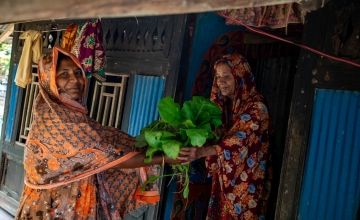
Knowledge Hub
Compost. Made by decomposing plant and food waste, recycling organic materials, and manure. Not the most exciting ingredients on the tin (or bag, as it is typically packaged), but transformative nonetheless. Let’s deep-dive straight into a pile of compost to find out exactly how it’s changing lives in some of the world’s most vulnerable communities.
What exactly is compost?
Compost is a mixture of ingredients used as plant fertiliser to improve soil's physical, chemical and biological properties. It is nature's way of recycling decomposed material into useful rich soil that is full of organic matter. There are four primary compost types: compost, farmyard manure, green manure, and vermicompost.
In Bangladesh, where Concern runs a number of climate adaptation programmes, vermicompost is a big player. We provide the tools and training to cultivate vermicompost, and as a result see huge changes within the climate-vulnerable communities we work with.
What is vermicompost?

The main difference between compost and vermicompost is that the latter uses worms in the process of decomposition. One of the most significant advantages of vermicomposting is that it has more nutrients than traditional composting.
Vermicompost is rich in phosphorus, potassium, and nitrogen, all of which are important for plant health. As such, crops that use vermicompost, as opposed to traditional compost, are more likely to flourish.
Vermicomposting in Bangladesh

Concern’s CRAAIN (Collective responsibility, action and accountability for improved nutrition) project in the Bagerhat district of southern Bangladesh, focusses on reducing food insecurity and malnutrition to improve maternal and child nutrition. It achieves this through engaging communities and working in a number of areas, including agriculture.
As part of the CRAAIN project, people receive compost tools, training, saplings and seeds to kick start their agricultural farming; either to help them earn a living or feed their families – or both.
Asma Begum was introduced to the project in 2020. During the training part of the programme, Asma also received equipment and half a kilogram of earthworm so that she could begin making her own vermicompost to use as a natural fertiliser on her vegetables.
During the training, I learnt about the vermicompost production procedure, climate-smart technology, and biopesticides (which I am very interested in). I also learnt from the training how to cope with cyclones or any other kind of this storm in terms of agriculture techniques and cropping patterns.
Asma creates the vermicompost in rings.
It is a long process. First, she puts dry cow dung in a ring; she then adds the earthworm, which she covers again with dried cow dung. After the worms have eaten the dry cow dung, they give it up as a stool. This is what is known as the vermicompost. One cycle of the process takes around 45 days and produces 25kg of vermicompost, which Asma either sells or uses on her own land.

Asma has grown her vermicompost production significantly over the years. Concern provided just two compost rings, and now she has ten.
After receiving the training, I cultivated according to the training and my knowledge. I am now feeling more fruitful and am a very high-level agriculture and vermicompost entrepreneur in terms of this agriculture production.

Asma has reduced her use of chemical fertilisers, which she think why her leafy green vegetables are so green and delicious. Asma uses the vegetables she grows to feed herself and her family, and sells the excess at the market: “There is so much interest to purchase these products. When I display in any market, the product is lucrative and everyone want to buy because of this vermicompost production.”

Collaborating with compost
The CRAAIN project has not just Asma’s own development, but now, as a lead farmer, she teaches other members of her community how to make their own vermicompost too and has connections to 400 households overall.
“What I have learnt with CRAAIN I don’t just keep this within the house – I replicate the message to other community members. When anybody needs any help or solutions, they come to me or I go to the community and we learn together.”
Who knew compost could be so bountiful for friendships too.
Other ways to help
Donate now
Give a one-off, or a monthly, donation today.
Join an event
From mountain trekking to marathon running, join us for one of our many exciting outdoor events!
Buy a gift
With an extensive range of alternative gifts, we have something to suit everybody.
Leave a gift in your will
Leave the world a better place with a life-changing legacy.
Become a corporate supporter
We partner with a range of organisations that share our passion and the results have been fantastic.
Create your own fundraising event
Raise money for Concern by organising your own charity fundraising event.





